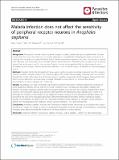| dc.contributor.author | Grant, Alan | |
| dc.contributor.author | Muskavitch, Marc | |
| dc.contributor.author | O’Connell, Robert J | |
| dc.date.accessioned | 2013-12-13T17:30:11Z | |
| dc.date.issued | 2013 | |
| dc.identifier.citation | Grant, Alan J, Marc A T Muskavitch, and Robert J O’Connell. 2013. Malaria infection does not affect the sensitivity of peripheral receptor neurons in anopheles stephensi. Parasites & Vectors 6: 134. | en_US |
| dc.identifier.issn | 1756-3305 | en_US |
| dc.identifier.uri | http://nrs.harvard.edu/urn-3:HUL.InstRepos:11375875 | |
| dc.description.abstract | Background: Mosquitoes transmit many important diseases including malaria, dengue and yellow fever. Disease transmission from one vertebrate host to another depends on repeated blood feedings by single mosquitoes. In order for the mosquito to acquire the blood that it needs to complete oogenesis, the insect must locate a suitable host. Olfactory cues (including carbon dioxide) released by the host and detected by the mosquito are the primary signals that vector insects use for host location. Previous studies have suggested that the physiological status - including bacterial, fungal, viral and Plasmodium infections - can modulate aspects of behavior in haematophagous insects. Methods: Standard electrophysiological techniques were used to record extracellular responses from the receptor neurons located in sensilla found on the maxillary palps of the insects. The recording microelectrode was inserted through the cuticle at the base of an individual sensillum and the extracellular electrical signals obtained from the three neurons within the sensillum were recorded. Stimulations consisted of 2 s pulses of the desired concentrations of CO2 or dosages of 1-octen-3-ol. Results: Accordingly, we were interested in determining whether Plasmodium infection affects the sensitivity of those peripheral olfactory sensors that are involved in host-seeking in mosquitoes. Our studies indicate that infection of female Anopheles stephensi with Plasmodium berghei does not alter the response characteristics of the neurons innervating the maxillary palp sensilla that respond to the attractants carbon dioxide and 1-octen-3-ol. Although the response characteristics of the peripheral sensory neurons are not affected by infection status, we found that the age of the mosquito alone does affect the threshold of sensitivity of these neurons to carbon dioxide. The proportion of older insects (21–30 d post-emergence) that responds to 150 ppm carbon dioxide is higher than the proportion that responds among younger insects (1–10 d post-emergence). Conclusions: Anopheles stephensi infected with Plasmodium berghei exhibit sensitivities to stimulation with carbon dioxide and 1-octen-3-ol similar to those of uninfected mosquitoes. However, the age of the infected or uninfected mosquito does affect the threshold of sensitivity of these neurons to carbon dioxide. | en_US |
| dc.language.iso | en_US | en_US |
| dc.publisher | BioMed Central | en_US |
| dc.relation.isversionof | doi:10.1186/1756-3305-6-134 | en_US |
| dc.relation.hasversion | http://www.ncbi.nlm.nih.gov/pmc/articles/PMC3659000/pdf/ | en_US |
| dash.license | LAA | |
| dc.subject | Infection | en_US |
| dc.subject | Carbon dioxide | en_US |
| dc.subject | 1-Octen-3-ol | en_US |
| dc.subject | Electrophysiology | en_US |
| dc.title | Malaria infection does not affect the sensitivity of peripheral receptor neurons in Anopheles stephensi | en_US |
| dc.type | Journal Article | en_US |
| dc.description.version | Version of Record | en_US |
| dc.relation.journal | Parasites & Vectors | en_US |
| dash.depositing.author | Grant, Alan | |
| dc.date.available | 2013-12-13T17:30:11Z | |
| dc.identifier.doi | 10.1186/1756-3305-6-134 | * |
| dash.contributor.affiliated | Grant, Alan | |
| dash.contributor.affiliated | Muskavitch, Marc | |


